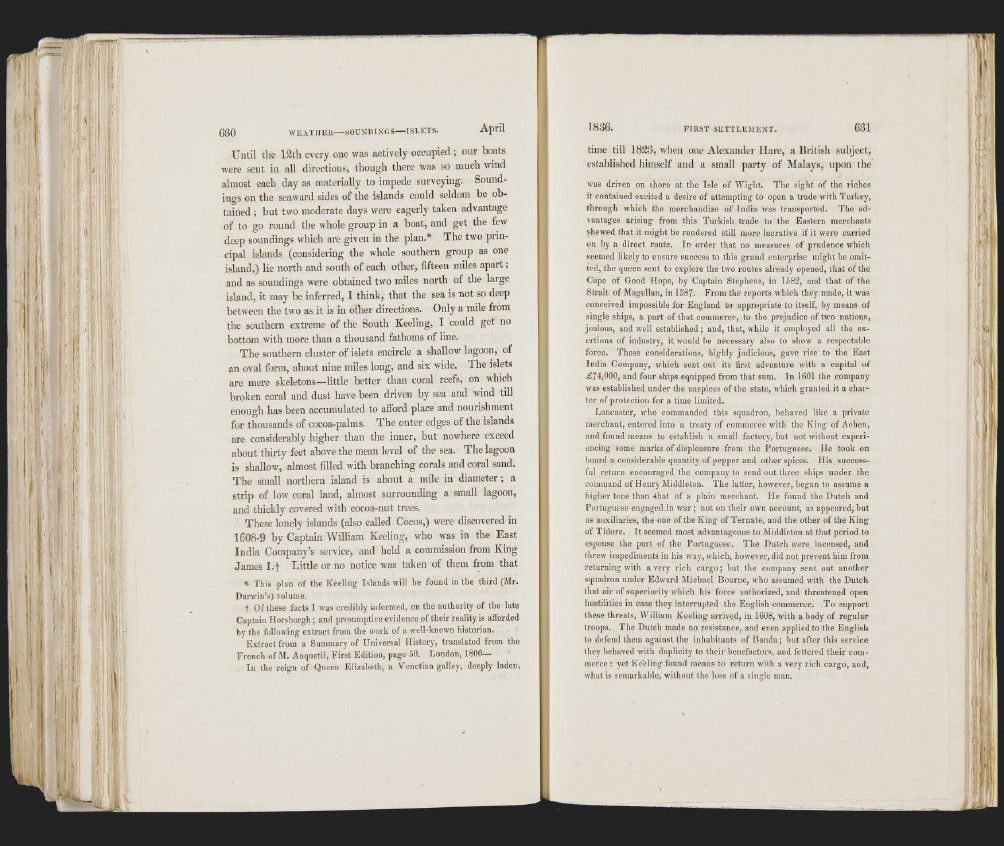
630
I I •
Until tlie 12th every one was actively occupied ; our boats
were sent in all directions, though there was so much wind
almost each day as materially to impede surveying. Soundings
on tlie seaward sides of the islands could seldom be obtained
; but two moderate days were eagerly taken advantage
of to go round the whole group in a boat, and get the few
deep soundings which are given in the plan.* The two principal
islands (considering the whole southern group as one
island,) lie north and south of each other, fifteen miles apart;
and as soundings were obtained two miles north of the large
island, it may be inferred, I think, that the sea is not so deep
between the two as it is in other directions. Only a mile from
the southern extreme of the South Keeling, I could get no
bottom with more than a thousand fathoms of line.
The southern cluster of islets encircle a shallow lagoon, of
an oval form, about nine miles long, and six wide. The islets
are mere skeletons—little better than coral reefs, on which
broken coral and dust have been driven by sea and wind till
enough has been accumulated to afford place and nourishment
for thousands of cocoa-palms. The outer edges of the islands
are considerably higher than the inner, but nowhere exceed
about thirty feet above the mean level of the sea. The lagoon
is shallow, almost filled with branching corals and coral sand.
The small northern island is about a mile in diameter ; a
strip of low coral land, almost surrounding a small lagoon,
and thickly covered with cocoa-nut trees.
These lonely islands (also called Cocos,) were discovered in
1608-9 by Captain William Keeling, who was in the East
India Company’s service, and held a commission from King
James I .f Little or no notice was taken of them from that
* This plan of the Keeling Islands will he found in the third (Mr.
Darwin’s) volume.
t Of these facts I was credibly informed, on the authority of the late
Captain Horsburgh ; and presumptive evidence of their reality is afforded
by the following extract from the work of a well-known historian.
' Extract from a Summary of Universal History, translated from the
French of M. Anquetil, First Edition, page 50. London, 1800—
In the reign of Queen Elizabeth, a Venetian galley, deeply laden.
time till 1823, when one Alexander Hare, a British subject,
established himself and a small party of Malays, upon the
was driven on shore at the Tsle of Wig'ht. The sight of the riches
it contained excited a desire of attempting to open a trade with Turkey,
through which the merchandize of India was transported. The advantages
arising from this Turkish trade to the Eastern merchants
shewed that it might be rendered still more lucrative if it were carried
on by a direct route. In- order that no measures of prudence which
seemed likely to ensure success to this grand enterprise might be omitted,
the queen sent to explore the two routes already opened, that of the
Cape of Good Hope, hy Captain Stephens, in 1582, and that of the
Strait of Magellan, in 1587. From the reports which they made, it was
conceived impossible for England to appropriate to itself, by means of
single ships, a part of that commerce, to the prejudice of two nations,
jealous, and well established ; and, that, while it employed all the exertions
of industry, it would he necessary also to show a respectable
force. These considerations, highly judicious, gave rise to the East
India Company, which sent out its first adventure with a capital of
¿6/4,000, and foui* ships equipped from that sum. In 1601 the company
was established under the auspices of the state, which granted it a charter
of protection for a time limited.
Lancaster, who commanded this squadron, behaved like a private
merchant, entered into a treaty of commerce with the King of Achen,
and found means to establish a small factory, but not without experiencing
some marks of displeasure from the Portuguese. He took on
board a considerable quantity of pepper and other spices. His successful
return encouraged the company to send out three ships under the
command of Henry Middleton. The latter, however, began to assume a
higher tone than 4hat of a plain merchant. He found the Dutch and
Portuguese engaged.in war ; not on their own account, as appeared, but
as auxiliaries, the one of the King of Ternate, and the other of the King
of Tidore. It seemed most advantageous to Middleton at that period to
espouse the part of the Portuguese. The Dutch were incensed, and
threw impediments in his way, which, however, did not prevent him from
returning with a very rich cargo; but the company sent out another
squadron under Edward Michael Bourne, who assumed with the Dutch
that air of superioj-ity which his force authorized, and threatened open
hostilities in case they interrupted the English commerce. To support
these threats, William Keeling arrived, in 1608, with a body of regular
troops. The Dutch made no resistance, and even applied to the English
to defend them against the inhabitants of Banda; but after this service
they behaved with duplicity to their benefactors, and fettered their commerce
: yet Keeling found means to return with a very rich cargo, and,
what is remarkable, without the loss of a single man.
K
I :
l.flA
I
I i i
fi